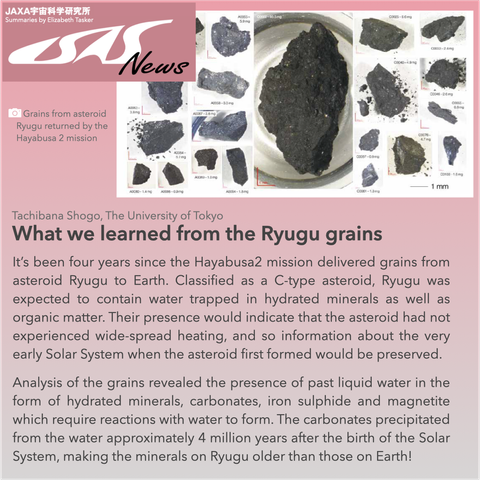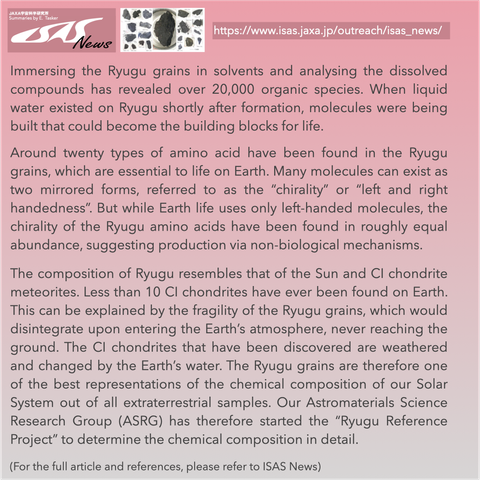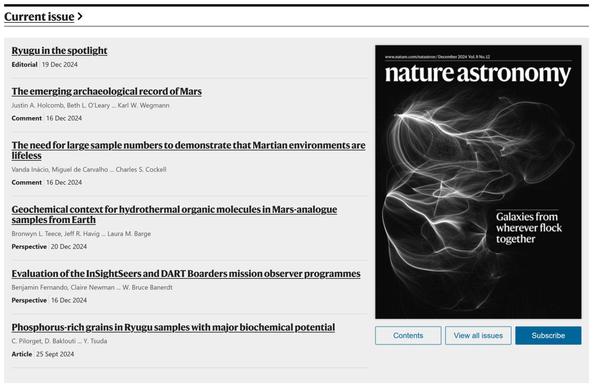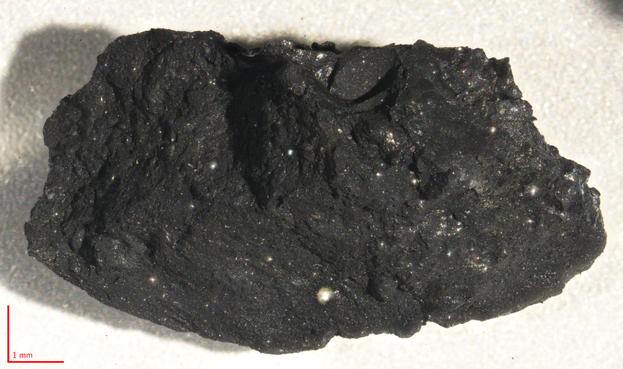Using artificial intelligence technology, a University of Tokyo team has managed to rapidly identify from photographs the size, location and shape of some 200,000 rocks on two asteroids. https://www.japantimes.co.jp/news/2025/04/08/japan/science-health/japan-ai-technology-asteroid-rocks/?utm_medium=Social&utm_source=mastodon #japan #sciencehealth #ai #space #asteroids #hayabusa #ryugu #universityoftokyo
#Ryugu
Hayabusa, l'expérience analogique.
A new edition of JAXA's #ISASNews newsletter has come out, sharing stories from the Institute of Space and Astronautical Science.
We put together short summaries in English! 🛰️ The first story is on results from the analysis of asteroid #Ryugu, brought home by the #Hayabusa2 mission.
And if these are tantalisingly epic, you can wrestle down the full stories (in Japanese) here: https://www.isas.jaxa.jp/outreach/isas_news/
SciTech Chronicles. . . . . . . . .Feb 18th, 2025
#Ryugu #salt #precipated #sodium #solar-wind #beryllium-10 #interstellar #heliosphere #LIDAR #Zapotec #Guiengola #Tehuantepec #AI #decode #aphasia #converter #Ba3SiO5 #ruthenium #ammonia #mixed-anion
A new paper also from the other asteroid sample return misson: https://academic.oup.com/mnras/article/537/1/127/7945217?login=false = Photometry of (162173) #Ryugu and its artificial crater as inferred by Hayabusa2/ONC images.
Nature Astronomy's current issue: Ryugu galore, Mars aplenty, and a pinch of Cosmology - with the cover image by yours truly!
https://www.nature.com/natastron
#PlanetaryScience #Cosmology #Ryugu #Mars #science #STEM #Astrodon
Researchers from Imperial College London have discovered that a #space-returned sample from #asteroid #Ryugu was rapidly colonized by terrestrial microorganisms, even under stringent #contamination control measures.
Results of the study determined that terrestrial biota had rapidly colonized the extraterrestrial material, even under strict contamination control (opened in nitrogen in a class 10,000 clean room).
https://phys.org/news/2024-11-ryugu-asteroid-sample-rapidly-colonized.html
Shocking Discovery of Earth Bacteria Inside Ryugu Asteroid Samples + Other Updates - YouTube
https://www.youtube.com/watch?v=mO46CNftRDs
Bacteria found in asteroid sample – but they're not from space
> The unexpected discovery of microbial life in a piece of rock from an asteroid shows how hard it is to avoid contaminating samples brought back to Earth
Ten years after its launch, Hayabusa2 is continuing its journey through space to search for clues to the origins of life and water on Earth. https://www.japantimes.co.jp/news/2024/12/03/japan/science-health/japan-hayabusa-2-ten-years/?utm_medium=Social&utm_source=mastodon #japan #sciencehealth #hayabusa2 #jaxa #space #asteroids #ryugu
Chalk this one up to 'Life, uh, finds a way' and the seeming impossibility of creating an utterly sterile location on Earth
https://phys.org/news/2024-11-ryugu-asteroid-sample-rapidly-colonized.html
#Asteroid #Ryugu (and closely related CI-chondrites) may have its origin closer to the Sun than previously thought: not beyond #Saturn, but near #Jupiter. #mpsgoettingen scientists report on measurements of Ryugu’s nickel isotope composition in @ScienceAdvances. Read more here: https://www.mps.mpg.de/a-new-birthplace-for-asteroid-ryugu?c=6775 Link to paper: https://www.science.org/doi/10.1126/sciadv.adp2426
#MPS:
"Ein neuer Geburtsort für Asteroid Ryugu
Proben des Asteroiden Ryugu sorgen erneut für eine Überraschung – und stellen bisherige Vorstellungen von der Entstehung kohlenstoffreicher Asteroiden in Frage."
https://www.mps.mpg.de/ein-neuer-geburtsort-fuer-asteroid-ryugu?c=2728
27.9.2024
#Astronomie #Asteroid #Hayabusa2 #kohligeChondrite #Nickel #Raumsonde #Ryugu #Sonnensystem
[SummerNews #5 ] For the first time, large-scale #PAHs (polycyclic aromatic hydrocarbons) (> 50 #carbon atoms) have been discovered in a carbonaceous #asteroid sample: #Ryugu 👍 👏
Brought back by the #Hayabusa2 mission from JAXA, this sample was the subject of a unique #surface mass spectrometry technique based on two-stage #laser desorption/ionization, available on the #AROMA device at IRAP.
[ActuEstivale #5] Pour la première fois, des #PAH (hydrocarbures aromatiques polycycliques) de grande taille (> 50 atomes de #carbone) ont été découverts dans un échantillon d' #astéroïde carboné : #Ryugu 👍 👏
Rapporté par la mission #Hayabusa2 de la JAXA, cet échantillon a fait l'objet d'une technique unique de #spectrométrie de masse de surface basée sur la désorption/ionisation #laser en deux étapes, disponible sur le dispositif #AROMA à l’IRAP..
[#BackOnline 💫] Rendez-vous dès demain mardi pour notre récap' des actus de l'été 👀 Un petit aperçu ci-après ... 🤩 🧐
L'impact environnemental des activités astronomiques, la magnétosphère de #Jupiter à l'ère de la sonde Juno, les récentes découvertes de BepiColombo autour de #Mercure, le survol de la Terre et de la Lune par la sonde #Juice, la découverte de grandes molécules aromatiques polycycliques interstellaires au sein de l’astéroïde #Ryugu ...
Stay tuned 😍
"Sample of asteroid (162173) Ryugu retrieved by Hayabusa2 sample return mission. At about 10 mm long, this fragment (ID C9000(CXL)) is the largest particle registered in the Ryugu Sample Database."
ISAS/JAXA, CC BY 4.0, via Wikimedia Commons.
The #evolution of #organic #material on #Asteroid 162173 #Ryugu and its delivery to #Earth https://www.nature.com/articles/s41467-024-50004-w
Studies of samples of asteroid Ryugu returned by the Hayabusa-2 mission show that the action of water and organic material on carbonaceous asteroids lead to the widespread occurrence of micron-sized #polymeric organic particles encapsulating clays and biological relevant #molecules.





